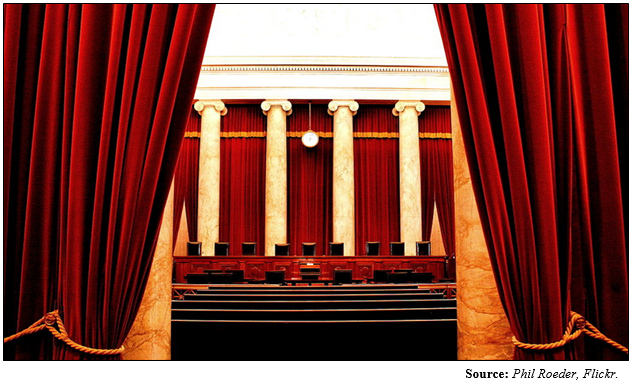By Natalia Castro
Throughout Donald Trump’s presidency thus far, left-leaning courts have tried to overrule his constitutional and legal authority; last week the highest court in the land sent the message that this practice is unacceptable, and reinstated the vast majority of the President’s temporary travel ban against immigrants and refugees from six Muslim-majority countries.
In a 9-0 decision, the Supreme Court agreed to grant a stay on lower court injunctions against the travel ban, allowing it to take effect, with limited exceptions for individuals with close familial relationships, individuals on student visas, and individuals on employment visas. While this is a big win for President Trump, it took a while to get here.
Within weeks of Trump enacting Executive Order: Protecting the Nation From Foreign Terrorist Entry into the United States, lower court federal judges had blocked portions of the order from taking effect in their states. On February 3rd, 2017, a district judge from Washington State ruled that the states that filed lawsuits against the travel ban, “have met their burden of demonstrating that they face immediate and irreparable injury as a result of the signing and implementation of the executive order.”
That, despite the reality that presently 16 “travel bans” or Presidential Proclamations limiting travel, are in effect in various Latin American, Middle Eastern, and African countries. Travel bans are a common policy option for Presidents, but apparently not President Trump, in the lower courts’ eyes.
In a three-judge panel in the Ninth District Court, judges ruled against reinstating the travel ban just weeks later. The court used Trump’s campaign statements and tweets to conclude Trump was unfairly targeting Muslim countries and violating the First Amendment right to immigrate to the U.S. — a First Amendment right that somehow never even existed until the courts ruled in 2017.
The court also took issue with whether the travel ban had applied to those who were in the midst of travel when the ban took effect. The administration argued that it didn’t.
To appease his critiques, President Trump reissued the restrictions with changes to address certain issues. Trump’s second executive order stated, “Each of these countries is a state sponsor of terrorism, has been significantly compromised by terrorist organizations, or contains active conflict zones. Any of these circumstances diminishes the foreign government’s willingness or ability to share or validate important information about individuals seeking to travel to the United States. Moreover, the significant presence in each of these countries of terrorist organizations, their members, and others exposed to those organizations increases the chance that conditions will be exploited to enable terrorist operatives or sympathizers to travel to the United States.”
This version of the ban even excluded Iraq, because of Iraq’s recent efforts to enhance its travel documentation procedures. While these courts have been acting politically to paint Trump as anti-Islamic, the President worked to show the courts that his primary interest is national security.
Yet, the Ninth Circuit ruled once again in June that the Executive Order was unconstitutional.
Now, the Supreme Court has finally reminded the lower courts of their place. District courts have attempted to increase their political clout through their rulings, but the Supreme Court’s staying their injunction, allowing most of the travel restrictions to take effect implicitly denies the dubious First Amendment grounds that were raised in the case.
As Americans for Limited Government President Rick Manning stated in a press release, “This is a return to the rule of law, where the Supreme Court for now has refused to affirm lower court rulings that were not based on the actual laws and policies in question, but instead on political campaign rhetoric with no bearing on the actual case. For now, this is a huge victory not only for the Trump administration, but for the constitutional separation of powers.”
Most notably, the restrictions were only written to take place for 90 to 120 days in order to give the Department of Homeland Security time to improve their vetting procedure.
This was a necessary goal considering the LA Times of Jan. 2017 report of a glitch in the vetting system which was discovered in 2015 and prevented U.S. officials from conducting background checks on refugees. According to the report, “The refugees whose cases are under review include one who failed a polygraph test when he applied to work at a U.S. military installation overseas and another who may have been in communication with an Islamic State leader.”
Yet by the time the court is ready to hear the case on this issue, those 90 days will be over. By then, the Department of Homeland Security will have issued its new vetting procedures and the travel restrictions will be lifted — provided immigrants and refugees can meet up with the stringent new vetting. There will be no reason for the entire First Amendment, Trump racism case the left has been building. It will be moot.
Instead, the Supreme Court could be looking toward a narrow ruling that addresses the effect of the ban’s implementation on individuals that already had visas at the time who were met with issues at airports, or another minuscule portion of the ban that still matters in October.
This was a victory for both President Trump and the constitutional rule of law. The Supreme Court reaffirmed their place as a politically neutral, constitutionally driven body. Trump’s travel restrictions were and are constitutional and now in its final hurdles, the liberal judges attempting to destroy it, have been largely silenced.
Natalia Castro is a contributing editor at Americans for Limited Government.







